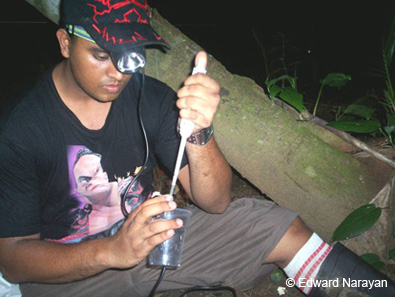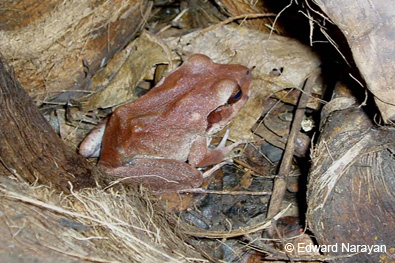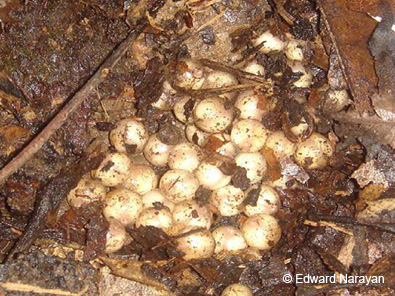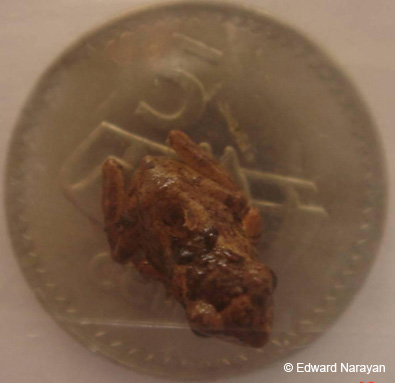The EDGE Programme seeks to prioritise the conservation of around 10% of the world’s amphibian species – otherwise known as the 799 EDGE Amphibians!
These amphibians represent the most unusual and threatened of their kind. We are contacted by incredible people throughout the world who work to research and conserve these precious species, and today we would like to present the project of Edward Narayan, a Fijian Ph.D. student working on the Endangered Fijian ground frog (Platymantis vitiana) – EDGE amphibian 505.
Edward Narayan has sent us the following information to raise awareness of his work:
A project undertaken at the Faculty of Science and Technology, Biology Division University of the South Pacific, Fiji, and implemented by Edward Narayan
Local Fijian scientist Edward Narayan collecting field data from Fijian ground frog
Emphasis: To help save an Endangered Fijian Frog from the amphibian extinction crisis – Fiji Islands
PhD Thesis Topic: Biology of endangered Fijian ground frog (Platymantis vitiana) – Fiji Islands: Breeding and Reproductive Endocrinology
Synopsis
Despite being listed as Endangered on the 2008 IUCN (World Conservation Union) Red List of Threatened Species and intense conservation efforts on its behalf, little is known about the reproductive biology of the Fijian ground frog (Platymantis vitiana). Breeding is important for species survival and hormones are the essence of reproduction. The certain aspects of captive breeding and reproductive endocrinology of the Fijian ground frog is studied so that the basic reproductive patterns can be understood.
Fijian ground frog (Platymantis vitiana)
The breeding of the Fijian ground frog is being studied in a purpose-built outdoor enclosure based at the University of the South Pacific (USP), Fiji Islands, as an insurance policy while invasive species eradication work is on-going on Viwa Island (one of the five remaining mongoose-free (Herpestes javanicus) island habitats of the Fijian ground frog).
The primary focus of captive breeding is to establish an ex situ captive management strategy, egg-embryo management and monitoring the health status of the Fijian ground frog. Under the ex situ captive management strategy, the ex situ micro-environmental preferences and the association between the ex situ climate and the activity (nocturnal behavior and movement) of the Fijian ground frog are tested.
Fijian ground frog eggs in a terrestrial nest
The reproductive endocrinology of the Fijian ground frog is being studied in captivity at the USP and a sub-population of frogs present on Viwa Island. The reproductive (testosterone, progesterone and oestradiol) and stress (corticosterone) hormone metabolites present in the urine samples of the Fijian ground frog will be assayed using enzyme immunoassay (EIA).
The approach involves monitoring the reproductive and stress hormones in captive frogs through both breeding and non-breeding periods, comparing measures obtained with those from in situ populations and correlating findings with the observed reproductive status of individuals. Measures of hormone metabolites are made from voided urine, meaning that the technique has the advantage of being totally non-invasive.
The knowledge gained would underpin improved captive management protocols that are likely to increase breeding success than what is currently achievable with the potential then of providing animals for re-establishing in the wild.
A captive management protocol for the Fijian ground frog will be presented for zoological parks and specific individuals with aim to preserve this species in captivity as an insurance policy against a possible extinction crisis.
Background
Currently, the Fijian ground frog is listed as Endangered (EN) under the Red List Category, EN B1 ab (v), because its extent of occurrence (range) is less than 5,000 km sq, its distribution is severely fragmented, and the frog numbers are considered to be declining in the wild. They have been extirpated from several Fijian Islands, e.g. Viti Levu.
Historical records of The Fijian ground frog have been made from Viti Levu, Vanua Levu, Taveuni, Koro, Gau, Kadavu and Viwa but they are now only found on four mongoose-free islands (Taveuni, Gau, Viwa and Ovalau) and a remnant population in Vanua Levu. It has been suggested that cane toads (Chaunus marinus – formerly Bufo marinus) and Fijian ground frogs compete for food, which raises great concern regarding the long term population viability of this species.
Fijian ground froglet on a small Fijian coin
On Viwa, work on distribution patterns and population studies of the Fijian ground frog are continuing together with strategic eradication project to eradicate the Invasive Alien Species (IAS) off the natural habitats. Despite its dramatic decrease little data exist on the Fijian ground frog including conservation and next to nothing is known about its ecology and effects of invasive species on its abundance and distribution. As a result, knowledge of the reproductive biology of the Fijian ground frog is limited.
The establishment of a captive population of the Fijian ground frog in captivity can be viewed as an insurance policy while invasive species eradication work is on-going on Viwa Island (one of the five remaining mongoose free island habitats of the Fijian ground frog). Furthermore, reproductive hormone monitoring would significantly improve understanding of the endocrinology and reproductive physiology of the Fijian ground frog.
I will be very happy if I could be supported to gather further information so that I can do better monitoring of the reproduction and ecology of Fijian ground frog in their natural habitats and gather more baseline scientific data on this species before it goes extinct in the near future. This information will help conserve this amazing species into the future!
Some of the things which I need in order to carry out my work are equipment like good head torches, sleeping bag, GPS device, and a digital camera. I mention these because if some generous person could help with such items if they don’t wish to support with money then it will be a very big help for my research as well.
Prepared by: Edward Jitik Narayan
PhD Scholar
Biology Division
University of the South Pacific
Fiji Islands
edward_nryn@yahoo.com
If you would like to donate funding to Edward’s important project, please contact him directly using the details above or write to EDGE at info@edgeofexistence.org
Thank you.




